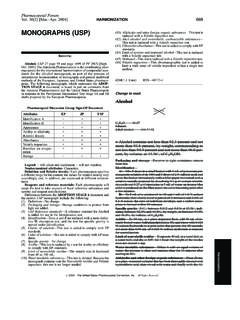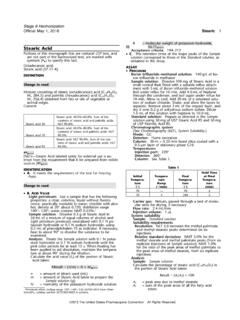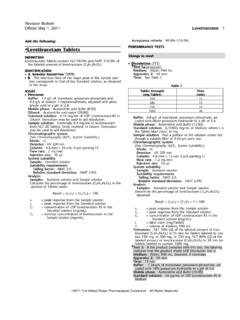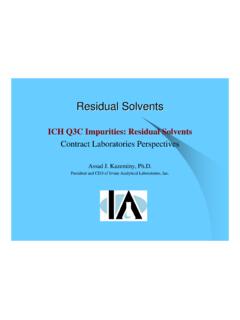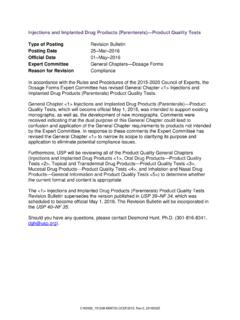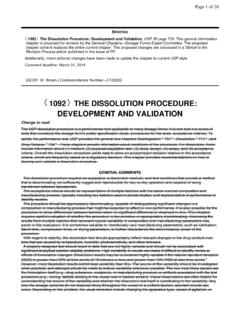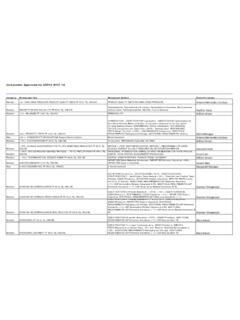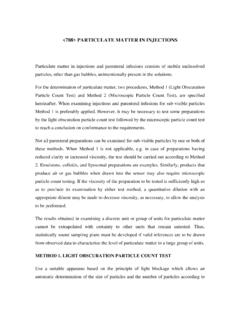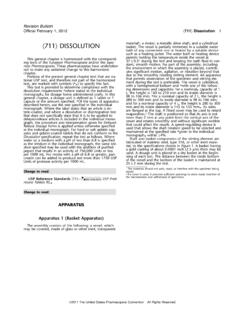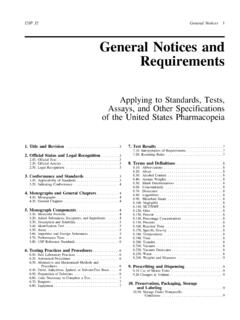Transcription of General Chapters <797> Pharmaceutical Compounding ...
1 General Chapters <797> Pharmaceutical Compounding Sterile Preparations Type of Posting Revision Bulletin Posting Date24 Apr 2020 Official Date01 May 2020 Expert CommitteeCompounding Reason for Revision Compliance Appeals Panel Decision In accordance with the Rules and Procedures of the 2015 2020 Council of Experts, USP is updating the status of Pharmaceutical Compounding Sterile Preparations <797> based on the Appeals Panel decision. The currently official <797>, last revised in 2008, remains official. On June 1, 2019, USP published revisions to General Chapter <795> for nonsterile Compounding and General Chapter <797> for sterile Compounding , as well as a new General Chapter <825> for radiopharmaceuticals.
2 After publication of the revised and new Compounding standards, USP received appeals on certain provisions in <795>, <797>, and <825>. In accordance with USP s Bylaws, the responsible Expert Committees considered the information raised in the appeals and issued decisions on the appeals (see Decisions on Appeals to USP <795> and <797> and <825>). As part of the formal USP appeals process, four (4) stakeholders who submitted appeals to the Compounding Chapters requested further review by an appointed Appeals Panel. After thoughtful deliberation and evaluation of the record and hearings from the appellants on January 21 and 22, 2020, the Appeals Panel granted the appeals to General Chapters <795> and <797> and has remanded the Chapters to the Compounding Expert Committee (CMP EC) with the recommendation for further engagement on the issues raised concerning the beyond-use date provisions.
3 The purpose of this revision bulletin is to align the display of the currently official version of the chapter in the USP-NF platform with the Appeals Panel decision. No revisions to the official text are being made. The platform will be updated to clarify that the currently official <797>, last revised in 2008, remains official. Should you have any questions, please contact the Healthcare Quality & Safety Team C262455-M99925-CMP2015, rev. 00 20200224 797 Pharmaceutical Compounding STERILE PREPARATIONSAdd the following: To view the Notice that posted in conjunction with this accelerated revision, please click (RB 1-May-2020)INTRODUCTIONThe objective of this chapter is to describe conditions and practices to prevent harm, including death, to patients that couldresult from (1) microbial contamination (nonsterility), (2) excessive bacterial endotoxins , (3) variability in the intended strengthof correct ingredients that exceeds either monograph limits for official articles (see General Notices, Official Articles) or 10%for nonofficial articles, (4)
4 Unintended chemical and physical contaminants, and (5) ingredients of inappropriate quality incompounded sterile preparations (CSPs). Contaminated CSPs are potentially most hazardous to patients when administeredinto body cavities, central nervous and vascular systems, eyes, and joints, and when used as baths for live organs and CSPs contain excessive bacterial endotoxins (see bacterial endotoxins Test 85 ), they are potentially most hazardous topatients when administered into the central nervous the extensive attention in this chapter to the provision, maintenance, and evaluation of air quality, the avoidance ofdirect or physical contact contamination is paramount.
5 It is generally acknowledged that direct or physical contact of criticalsites of CSPs with contaminants, especially microbial sources, poses the greatest probability of risk to patients. Therefore, Compounding personnel must be meticulously conscientious in precluding contact contamination of CSPs both within andoutside ISO Class 5 (see Table 1) achieve the above five conditions and practices, this chapter provides minimum practice and quality standards for CSPsof drugs and nutrients based on current scientific information and best sterile Compounding practices.
6 The use of technologies,techniques, materials, and procedures other than those described in this chapter is not prohibited so long as they have beenproven to be equivalent or superior with statistical significance to those described herein. The standards in this chapter do notpertain to the clinical administration of CSPs to patients via application, implantation, infusion, inhalation, injection, insertion,instillation, and irrigation, which are the routes of administration. Four specific categories of CSPs are described in this chapter:low-risk level, medium-risk level, and high-risk level, and immediate use.
7 Sterile Compounding differs from nonsterilecompounding (see Pharmaceutical Compounding Nonsterile Preparations 795 ) primarily by requiring the maintenance ofsterility when Compounding exclusively with sterile ingredients and components ( , with immediate-use CSPs, low-risk levelCSPs, and medium-risk level CSPs) and the achievement of sterility when Compounding with nonsterile ingredients andcomponents ( , with high-risk level CSPs). Some differences between standards for sterile Compounding in this chapter andthose for nonsterile Compounding in Pharmaceutical Compounding Nonsterile Preparations 795 include, but are not limitedto, ISO-classified air environments (see Table 1); personnel garbing and gloving; personnel training and testing in principlesand practices of aseptic manipulations and sterilization; environmental quality specifications and monitoring; and disinfectionof gloves and surfaces of ISO Class 5 (see Table 1) 1.
8 ISO Classification of Particulate Matter in Room Air (limits are in particles of m and larger per cubic meter [current ISO]and cubic feet [former Federal Standard No. 209E, FS 209E])*Class NameParticle CountISO FS 209 EISO, m3FS 209E, ft33 Class 10352105 Class 1003,5201006 Class 1,00035,2001,0007 Class 10,000352,00010,0008 Class 100,0003,520,000100,000*Adapted from former Federal Standard No. 209E, General Services Administration, Washington, DC, 20407 (September 11, 1992) and ISO 14644-1:1999,Cleanrooms and associated controlled environments Part 1: Classification of air cleanliness.
9 For example, 3,520 particles of m per m3 or larger (ISO Class 5)is equivalent to 100 particles per ft3 (Class 100) (1 m3 = ft3).The standards in this chapter are intended to apply to all persons who prepare CSPs and all places where CSPs are prepared( , hospitals and other healthcare institutions, patient treatment clinics, pharmacies, physicians practice facilities, and otherlocations and facilities in which CSPs are prepared, stored, and transported). Persons who perform sterile Compounding includepharmacists, nurses, pharmacy technicians, and physicians.
10 These terms recognize that most sterile Compounding is performedby or under the supervision of pharmacists in pharmacies and also that this chapter applies to all healthcare personnel whoprepare, store, and transport CSPs. For the purposes of this chapter, CSPs include any of the following:1. Compounded biologics, diagnostics, drugs, nutrients, and radiopharmaceuticals, including but not limited to thefollowing dosage forms that must be sterile when they are administered to patients: aqueous bronchial and nasalinhalations, baths and soaks for live organs and tissues, injections ( , colloidal dispersions, emulsions, solutions,suspensions), irrigations for wounds and body cavities, ophthalmic drops and ointments, and tissue BulletinOfficial May 1, 2020 797 1 2020 The United States Pharmacopeial Convention All Rights , rev.
